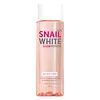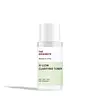What's inside
What's inside
 Key Ingredients
Key Ingredients

 Benefits
Benefits

 Concerns
Concerns

 Ingredients Side-by-side
Ingredients Side-by-side

Water
Skin ConditioningButylene Glycol
HumectantSalicylic Acid
MaskingPolysorbate 20
EmulsifyingGlycolic Acid
BufferingPotassium Hydroxide
BufferingPhenoxyethanol
PreservativeBis-PEG-12 Dimethicone
EmollientChlorphenesin
AntimicrobialPPG-26-Buteth-26
Skin ConditioningDisodium EDTA
PEG-40 Hydrogenated Castor Oil
EmulsifyingParfum
MaskingEthylhexyl Methoxycinnamate
UV AbsorberNiacinamide
SmoothingSodium Hyaluronate
HumectantGlycerin
HumectantButyl Methoxydibenzoylmethane
UV AbsorberEthylhexyl Salicylate
UV AbsorberHamamelis Virginiana Leaf Water
AstringentSodium Polyglutamate
HumectantTrehalose
HumectantCI 15985
Cosmetic ColorantCitric Acid
BufferingCI 17200
Cosmetic ColorantXylitylglucoside
HumectantAnhydroxylitol
HumectantPotassium Sorbate
PreservativeSodium Benzoate
MaskingXylitol
HumectantLeontopodium Alpinum Extract
Skin ConditioningCaprylic/Capric Triglyceride
MaskingGlucose
HumectantHydrogenated Lecithin
EmulsifyingPanax Ginseng Callus Culture Extract
Skin ConditioningCholesterol
EmollientWater, Butylene Glycol, Salicylic Acid, Polysorbate 20, Glycolic Acid, Potassium Hydroxide, Phenoxyethanol, Bis-PEG-12 Dimethicone, Chlorphenesin, PPG-26-Buteth-26, Disodium EDTA, PEG-40 Hydrogenated Castor Oil, Parfum, Ethylhexyl Methoxycinnamate, Niacinamide, Sodium Hyaluronate, Glycerin, Butyl Methoxydibenzoylmethane, Ethylhexyl Salicylate, Hamamelis Virginiana Leaf Water, Sodium Polyglutamate, Trehalose, CI 15985, Citric Acid, CI 17200, Xylitylglucoside, Anhydroxylitol, Potassium Sorbate, Sodium Benzoate, Xylitol, Leontopodium Alpinum Extract, Caprylic/Capric Triglyceride, Glucose, Hydrogenated Lecithin, Panax Ginseng Callus Culture Extract, Cholesterol
Water
Skin ConditioningGlycerin
HumectantButylene Glycol
HumectantPhenoxyethanol
PreservativeLactobionic Acid
BufferingNiacinamide
SmoothingMethylparaben
PreservativeAllantoin
Skin ConditioningGlycolic Acid
BufferingSodium Hydroxide
BufferingEthylhexylglycerin
Skin ConditioningDisodium EDTA
Salicylic Acid
MaskingXanthan Gum
EmulsifyingSodium Hyaluronate
HumectantSalix Alba Bark Extract
AstringentPropanediol
Solvent1,2-Hexanediol
Skin ConditioningCentella Asiatica Extract
CleansingDextrin
AbsorbentArtemisia Argyi Leaf Extract
Skin ConditioningCaprylhydroxamic Acid
Water, Glycerin, Butylene Glycol, Phenoxyethanol, Lactobionic Acid, Niacinamide, Methylparaben, Allantoin, Glycolic Acid, Sodium Hydroxide, Ethylhexylglycerin, Disodium EDTA, Salicylic Acid, Xanthan Gum, Sodium Hyaluronate, Salix Alba Bark Extract, Propanediol, 1,2-Hexanediol, Centella Asiatica Extract, Dextrin, Artemisia Argyi Leaf Extract, Caprylhydroxamic Acid
Ingredients Explained
These ingredients are found in both products.
Ingredients higher up in an ingredient list are typically present in a larger amount.
Butylene Glycol (or BG) is used within cosmetic products for a few different reasons:
Overall, Butylene Glycol is a safe and well-rounded ingredient that works well with other ingredients.
Though this ingredient works well with most skin types, some people with sensitive skin may experience a reaction such as allergic rashes, closed comedones, or itchiness.
Learn more about Butylene GlycolDisodium EDTA plays a role in making products more stable by aiding other preservatives.
It is a chelating agent, meaning it neutralizes metal ions that may be found in a product.
Disodium EDTA is a salt of edetic acid and is found to be safe in cosmetic ingredients.
Learn more about Disodium EDTAGlycerin is already naturally found in your skin. It helps moisturize and protect your skin.
A study from 2016 found glycerin to be more effective as a humectant than AHAs and hyaluronic acid.
As a humectant, it helps the skin stay hydrated by pulling moisture to your skin. The low molecular weight of glycerin allows it to pull moisture into the deeper layers of your skin.
Hydrated skin improves your skin barrier; Your skin barrier helps protect against irritants and bacteria.
Glycerin has also been found to have antimicrobial and antiviral properties. Due to these properties, glycerin is often used in wound and burn treatments.
In cosmetics, glycerin is usually derived from plants such as soybean or palm. However, it can also be sourced from animals, such as tallow or animal fat.
This ingredient is organic, colorless, odorless, and non-toxic.
Glycerin is the name for this ingredient in American English. British English uses Glycerol/Glycerine.
Learn more about GlycerinGlycolic Acid is arguably the most famous alpha hydroxy acid (AHA) with tons of research backing its benefits.
It is found naturally in sugar cane but the form used in skincare is usually synthetic for purity and stability.
Glycolic acid removes the top layer of dead skin cells to allow newer and fresher ones to emerge.
AHAs work by breaking down the structural “glue” that holds old skin cells in place. When that buildup is gone, your skin can renew itself more efficiently.
Research also shows glycolic acid stimulates collagen production, helping to firm and thicken the skin over time. This is one of its biggest advantages over other AHAs.
Overall, glycolic acid helps with:
Fun fact: Glycolic acid boosts skin hydration by helping it produce molecules that increase hyaluronic acid naturally.
To work best, glycolic acid products should have a pH between 3-4 (that’s where exfoliation is most effective but still gentle on skin).
The pH and concentration of a product are key to its effectiveness:
It is normal to feel a slight stinging sensation when using glycolic acid. This usually fades as your skin adjusts.
Because glycolic acid has the smallest molecular size in the AHA family, it can penetrate deeper, which enhances its effectiveness but also makes it more likely to irritate sensitive skin.
If your skin is very sensitive or prone to rosacea, glycolic acid may be too strong; in that case, try milder options like lactic acid or a PHA instead.
Recent studies suggest glycolic acid might even help protect against UV damage. But don’t skip sunscreen! Freshly exfoliated skin is more sensitive to the sun.
Glycolic acid is a skincare superstar. It smooths, brightens, hydrates, and firms the skin. Unless you’re highly sensitive, it’s well worth adding to your routine.
Read more about some other popular AHA's here:
Learn more about Glycolic AcidNiacinamide is a multitasking form of vitamin B3 that strengthens the skin barrier, reduces pores and dark spots, regulates oil, and improves signs of aging.
And the best part? It's gentle and well-tolerated by most skin types, including sensitive and reactive skin.
You might have heard of "niacin flush", or the reddening of skin that causes itchiness. Niacinamide has not been found to cause this.
In very rare cases, some individuals may not be able to tolerate niacinamide at all or experience an allergic reaction to it.
If you are experiencing flaking, irritation, and dryness with this ingredient, be sure to double check all your products as this ingredient can be found in all categories of skincare.
When incorporating niacinamide into your routine, look out for concentration amounts. Typically, 5% niacinamide provides benefits such as fading dark spots. However, if you have sensitive skin, it is better to begin with a smaller concentration.
When you apply niacinamide to your skin, your body converts it into nicotinamide adenine dinucleotide (NAD). NAD is an essential coenzyme that is already found in your cells as "fuel" and powers countless biological processes.
In your skin, NAD helps repair cell damage, produce new healthy cells, support collagen production, strengthen the skin barrier, and fight environmental stressors (like UV and pollution).
Our natural NAD levels start to decline with age, leading to slower skin repair, visible aging, and a weaker skin barrier. By providing your skin niacinamide, you're recharging your skin's NAD levels. This leads to stronger, healthier, and younger looking skin.
Another name for vitamin B3 is nicotinamide. This vitamin is water-soluble and our bodies don't store it. We obtain Vitamin B3 from either food or skincare. Meat, fish, wheat, yeast, and leafy greens contain vitamin B3.
The type of niacinamide used in skincare is synthetically created.
Learn more about NiacinamidePhenoxyethanol is a preservative that has germicide, antimicrobial, and aromatic properties. Studies show that phenoxyethanol can prevent microbial growth. By itself, it has a scent that is similar to that of a rose.
It's often used in formulations along with Caprylyl Glycol to preserve the shelf life of products.
Salicylic Acid (also known as beta hydroxy acid or BHA) is a well-known ingredient for treating skin that struggles with acne and clogged pores. It exfoliates both the skin's surface and deep within the pores to help clear out buildup, control oil, and reduce inflammation.
Unlike AHAs (alpha hydroxy acids), salicylic acid is oil-soluble. This allows it to penetrate into pores which makes it especially effective for treating blackheads and preventing future breakouts.
Salicylic acid is also known for its soothing properties. It has a similar structure to aspirin and can calm inflamed or irritated skin, making it a good option for acne-prone skin that is also sensitive.
Concentrations of 0.5-2% are recognized by the U.S. FDA as an over-the-counter topical acne product.
It can cause irritation and/or dryness if one's skin already has a compromised moisture barrier, so it's best to focus on repairing that before introducing this ingredient into your routine.
While salicylic acid does not increase sun sensitivity, it’s still important to wear sunscreen daily to protect your skin.
If you are looking for the ingredient called BHA or Butylated Hydroxyanisole, click here.
Learn more about Salicylic AcidSodium Hyaluronate is hyaluronic acid's salt form. It is commonly derived from the sodium salt of hyaluronic acid.
Like hyaluronic acid, it is great at holding water and acts as a humectant. This makes it a great skin hydrating ingredient.
Sodium Hyaluronate is naturally occurring in our bodies and is mostly found in eye fluid and joints.
These are some other common types of Hyaluronic Acid:
Learn more about Sodium HyaluronateWater. It's the most common cosmetic ingredient of all. You'll usually see it at the top of ingredient lists, meaning that it makes up the largest part of the product.
So why is it so popular? Water most often acts as a solvent - this means that it helps dissolve other ingredients into the formulation.
You'll also recognize water as that liquid we all need to stay alive. If you see this, drink a glass of water. Stay hydrated!
Learn more about Water